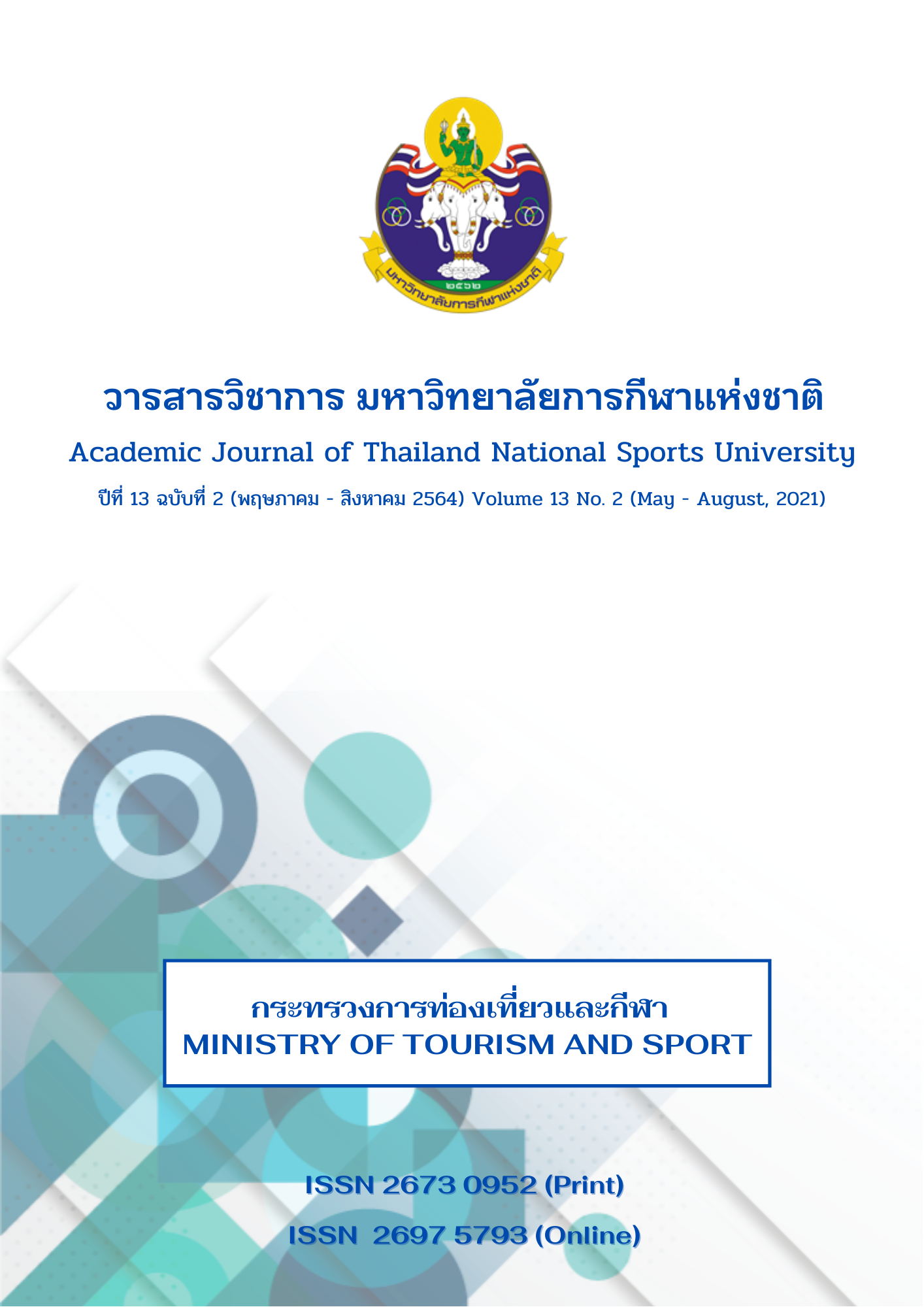KINEMATICS AND KINETICS ANALYSIS OF “JUMP FLOAT SERVE” IN THAI YOUTH NATIONAL WOMEN’S VOLLEYBALL PLAYER
Main Article Content
Abstract
Serving is one of the most dramatic skills in modern volleyball as a jump float serve which is performed in the international matches. Many international women players use the “jump float serve”. The purpose of this study was to describe the parameters of biomechanics in kinematic and kinetic characteristics of the volleyball jump float serve. Fifteen Thai national female youth players performed jump float serve. Two-dimensional analysis with a Sony Exmor Super 35 CMOS camera recording the players performed jump float serve. The statistics used for analysis was mean and SD. The results of maximum linear velocity of wrist, elbow, shoulder, hip, knee, and ankle were 10.5, 6.02, 3.78, 2.85, 4.24, and 6.05 m/s respectively, maximum linear acceleration of wrist, elbow, shoulder, hip, knee, and ankle were 240.83, 85.97, 58.05, 23.54, 30.86, and 61.51 m/s2 respectively. The maximum angular velocity of wrist, elbow, shoulder, hip, knee, and ankle were 4.28, 25.75, 8.09, 6.68, 11.74, and 2.09 rad/s respectively, and the maximum angular acceleration of wrist, elbow, shoulder, hip, knee, and ankle were 484.81, 685.83, 287.29, 300.29, 115.45, and 106.36 rad/s2 respectively. The maximum height of center of mass position was 1.57 m., as well as the maximum velocity of center of mass was 3.40 m/s, and the maximum of ball velocity was 70.89 km/hr. The maximum of mechanical energy was 1530.12 Nm with potential energy of 1168.95 Nm and kinetic energy of 392.6 Nm. The results from this study can provide useful information of joints motion for coach in order to focus on the training of the upper and lower parts of the body.
Article Details
The published article is a copyright of the Academic Journal of Thailand National Sports University. The passage appeared in each article in this academic journal is a perspective of each author which is not related to the journal. Each author is required to be responsible for all components of his/her own article. If there are any mistakes, each author must be responsible for those mistakes on his/her own.
References
Agelonidis, Y. (2004). The jump serve in volleyball from oblivion to dominance. Journal of Human Movement Studies, 47, 205-213.
Chung, C. K. Choi, "Three-dimensional kinematics of the spiking arm during the volleyball spike." Korean Journal of Sport Science 2: (1990) 124-151.
Coleman, S. G., Benham, A. S., & Northcott, S. R. (1993). A three-dimensional cinematographical analysis of the volleyball spike. Journal of Sports Sciences, 11(4), 295-302.
Hayrinen, M., Lahtinen, P., Mikkola, T., Honkanen, P., Paananen, A., & Blomqvist, M. (2007). Serve speed analysis in men’s volleyball. Science Success, 2, 10-11.
Huang, C., & Hu, L. H. (2007). Kinematic analysis of volleyball jump topspin and float serve. In H.J. Menzel & M.H. Chagas (Eds), 25 International Symposium on Biomechanics in Sports, (pp, 333-336). Ouro Preto, Brazil: ISBS.
Mehta, R. D. (2008). Sport ball aerodynamic. In H. Norstrud (Ed.), Sport Aerodynamics. (pp. 229-331). Italy: Springer.
Moras, G., Busca, B., Pena, J., Rodriguez, S., Vallejo, L., Tous-Fajardo, J., & Mujika, I. (2008). A comparative study between serve mode and speed and its effectiveness in a high-level volleyball tournament. The journal of sports medicine and physical fitness, 48(1), 31-36.
Reeser, J. C., Fleisig, G. S., Bolt, B., & Ruan, M. (2010). Upper limb biomechanics during the volleyball serve and spike. Sports health, 2(5), 368-374.
Reeser, J. C., Joy, E. A., Porucznik, C. A., Berg, R. L., Colliver, E. B., & Willick, S.E. (2010). Risk Factors for volleyball-related shoulder pain and dysfunction. The journal of injury, function, and rehabilitation, 2(1), 27-36.
Samson, J., & Roy, B. (1975). Biomechanical analysis of the volleyball spike. In Biomechanic V-B (edited by P.Komi) (pp.332-336). Baltimore: Baltimore University Press.
Sirirat Hirunrat, Phavadol Raktavee, Duangjun Phantayuth, & Saksayam Sawaengwaisayasuk. (2012). Kinematics analysis in jumping serve of Thai women volleyball national team. Sports science, Sports authority of Thailand.
Tsivika, M., & Papadopoulou, S. D. (2008). Evaluation of the technical and tactical offensive elements of the men’s European Volleyball Championships. Journal of Physical Training, 7, 1-16.


